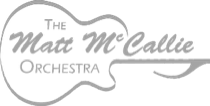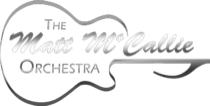Question: Can I provide my own DJ break music?
Answer: Yes, here's how.
We are sometimes asked if a music player such as an iPod, iPad, or iPhone, or other mobile device can be used. The answer is yes but you will want to take steps to ensure your files are properly prepared. Our sound system is very high quality and will reproduce a very honest and accurate sound from any source plugged into it. Professional audio, whether for stage or studio, is designed not just to sound good, but to sound as true to the original source as possible. Poor quality audio will be amplified so you need to use quality recordings.
Most portable music playing devices such as mp3 players are designed for tiny earbud speakers contributing to a lackluster sound quality when plugged into a professional P/A system. CDs are already greatly reduced in quality from live instruments so reducing that quality by half or more will be noticeable, particularly after having just listened to a set performed by an amazing live band.
Format:
Mp3 files are greatly reduced from their original quality. Most purchased mp3 files are roughly 5-10 MB whereas a direct reproduction of a CD recording at 44.1kHz as a WAV or AIFF file is typically 30-80 MB. We recommend using full CD quality formatting for the best sound quality.
Equalization:
One of the most important steps is to make certain the loudness of each track is similar from one song to another. Some music playing software such as iTunes will offer an equalizing option in their settings. For example in the iTunes Playback menu there is an option called Sound Check. You will want to have this box selected. Otherwise you will find that a quiet song will need to be turned up louder and the next song may blast the audience if it is too loud. This is one of the reasons you may want to hire a DJ since part of their job is to manage any such issues.
DJ break music is played during band breaks so there will usually be no one present to ride the faders of our board. As long as the quality of your digital files is properly prepared and there is no noise in the system we prefer you have the volume output on your device set to its loudest. Providing a strong signal from the source enables us to have headroom with the adjustments levels of our equipment.
For EQ settings we recommend the factory or flat equalization. Please provide your device for the band to prepare during it's soundcheck before the performance begins so that the volume and any necessary EQ settings can be adjusted on our board. If you are providing your own device we do not tamper with your settings, we only EQ through our system. Please also allow us the opportunity to become familiar with your device before we are expected to know how to navigate your files.
Airplane Mode:
When a phone is plugged into an external speaker the default setting is to have all audio play through the external speaker. This means if you receive a phone call or text while your phone is plugged into an external sound system it will ring through the speakers and interrupt your music.
Wi-Fi on the 3.4 GHz band is used by the majority of handheld devices these days including tablets and phones. Some of our live audio equipment shares the same band. Because your device will be plugged in to our sound system at close proximity to our wireless devices interference from your device can be transmitted through our system.
RFI and EMI are other types of interferences that can interfere with audio signals. Even with the highest quality cables that have excellent shielding, close proximity can still penetrate into the audio system.
Silence Notifications:
If your device has apps that provide notifications please make sure to silence them. Airplane mode only terminates your bluetooth, WiFi, and cellular connections. It does not silence your phone. Apps on your device such as calendars, games, and reminders may send audio notifications that will also play through your phone and interrupt the music. Some devices have the ability to silence all sound effects independently of the music being played back.
Adapters:
Most modern music playing devices use a 3.5mm or 1/8th" stereo jack. The cable to connect your device to our system or most other professional systems will need to have male TRS connections at each end. One end will need to be sized for your device at 3.5mm and the other end will need to be 1/4".
TRS cables with different sized male jacks at each end are rare. The most common solution is to use a reducer or enlarger coupling that will resize either an entirely 1/8th" or 1/4" cable. Not that one end of the coupler will need to be male, the other end female so that ultimately both ends of the cable are still male. Another less common cable option is to find a cable that is TRS at one end and male XLR at the other end. XLR to TRS cables are uncommon, especially one that uses 1/8" TRS. While XLR is preferably over TRS in the audio world for most situations, 1/4" TRS jacks are more common on more devices such as guitar, bass, and keyboard amps.
The cable should have a comfortable length of at least 3' so it may rest securely during playback and not vibrate and fall from where it is placed due to sound waves. We can provide the needed cables and adapters if notified in advance. The parts are typically hard to find locally.
If the steps to prepare your own pre-recorded music sound too involved we will gladly prepare the music for you for a very reasonable fee. You may also send us recordings of the songs you would like played in advance so we can have everything prepared by the time of your event.

















